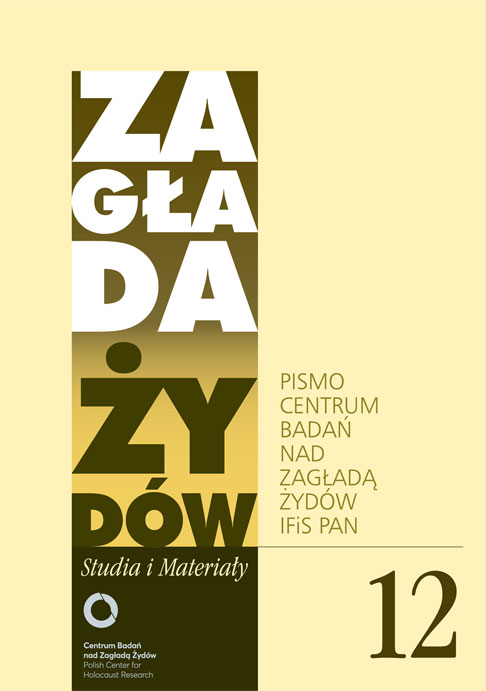Frankenstein w warszawskim getcie. Historia i legenda
Zagłada Żydów. Studia i Materiały, Nr 12 (2016), Strony: 187-208
Data zgłoszenia: 2020-10-19Data publikacji: 2016-11-30
 https://doi.org/10.32927/ZZSiM.414
https://doi.org/10.32927/ZZSiM.414
Abstrakt
The article deals with one exceptionally violent German perpetrator who was part of the occupation force in Warsaw during the Second World War. Inside the Ghetto he maltreated and killed a large number of women, children and men for his own personal pleasure. He did this to such an extensive degree that the population perceived him as monstrous being that was given the nickname „Frankenstein”. The article is mainly based on statements in juridical investigations, from the victim as well as from the perpetrator perspective, supplemented with some selected additional sources. Firstly the source corpus will be evaluated, to work out how these historical sources can be used to shed light on „Frankenstein”. This will be followed by an analysis of the actual identity of this perpetrator. It will be shown that he was, contrary to common belief, not necessarily the SS-Rottenführer Josef Blösche but more likely a member of the German Police Battalion 61. In the end the question will be also raised of how it was possible – despite all rules and regulations – that ghetto guards like him behaved like a marauding soldiery.
Słowa kluczowe
getto warszawskie , Zagłada , policja umundurowana , zbrodnie okupacyjne , warty w getcie , batalion policyjny , sprawca , przemoc , strach , terror , życie w getcie
Licencja
Prawa autorskie (c) 2016 Autor&"Zagłada Żydów. Studia i Materiały"

Utwór dostępny jest na licencji Creative Commons Uznanie autorstwa 4.0 Międzynarodowe.
https://creativecommons.org/licenses/by/4.0
Czasopismo publikowane jest w standardzie Diamond Open Access na licencji CC-BY-4.0 Deed - Uznanie autorstwa 4.0 Międzynarodowa - Creative Commons
Podobne artykuły
- Marian Turski, Przemowa ocalałego z getta łódzkiego wygłoszona 29 sierpnia 2019 r., w dniu obchodów 75. rocznicy likwidacji getta łódzkiego , Zagłada Żydów. Studia i Materiały: Nr 16 (2020)
- Bella Gutterman, Na warcie – o Cywii Lubetkin po aryjskiej stronie Warszawy i w powstaniu warszawskim , Zagłada Żydów. Studia i Materiały: Nr 8 (2012)
- Jacek Leociak, Stanisław Śreniowski, z księgi obłędu i ohydy , Zagłada Żydów. Studia i Materiały: Nr 1 (2005)
- Adam Kopciowski, Szama Grajer – „żydowski król” z Lublina , Zagłada Żydów. Studia i Materiały: Nr 16 (2020)
- Ewa Wiatr, „Zdawanie Żydów” – udział policjantów granatowych w wysiedlaniu Żydów na przykładzie powiatu radomszczańskiego , Zagłada Żydów. Studia i Materiały: Nr 10 (2014)
- Ferenc Laczó, Dokumentując odpowiedzialność. Jenő Lévai i narodziny historiografii Zagłady na Węgrzech w latach czterdziestych XX w. , Zagłada Żydów. Studia i Materiały: Nr 10 (2014)
- Adam Sitarek, Dziennik Viktora Hahna z łódzkiego getta [oprac. Adam Sitarek] , Zagłada Żydów. Studia i Materiały: Nr 16 (2020)
- Ewa Wiatr, Kawalerowie Krzyża Żelaznego w getcie łódzkim , Zagłada Żydów. Studia i Materiały: Nr 8 (2012)
- Wojciech Mądry, Zagłada ludności żydowskiej i polskiej w Miechowie widziana oczyma nastolatka. Nieopublikowane wspomnienia Andrzeja Wędzkiego z lat 1939–1945 , Zagłada Żydów. Studia i Materiały: Nr 17 (2021)
- Marta Janczewska , Official Medical Documents as a Source for Research of the Fate of Warsaw Jews 1939–1941 , Zagłada Żydów. Studia i Materiały: Nr Holocaust Studies and Materials (2013)
<< < 1 2 3 4 5 6 7 8 9 10 11 12 13 14 15 16 17 18 19 20 21 22 23 24 25 26 27 28 29 30 31 32 33 34 35 36 37 38 39 40 41 42 43 44 45 46 47 48 49 50 > >>
Możesz również Rozpocznij zaawansowane wyszukiwanie podobieństw dla tego artykułu.
 English
English
 Język Polski
Język Polski




